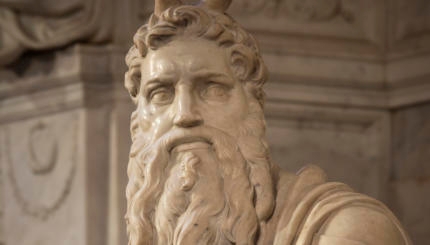Jews read sections of the
each week, and these sections, known as parshiyot, inspire endless examination year after year. Each week we will bring you regular essays examining these portions from a queer perspective, drawn from the Torah Queeries online collection, which was inspired by the book Torah Queeries: Weekly Commentaries on the Hebrew Bible. This week, Rabbi Jill Hammer considers the connections between impurities, power, and the roles of Moses’ sister Miriam.
The biblical categories tahor and tamei, usually translated “pure” and “impure,” mean something like insider/outsider. One who is tahor can enter the sanctuary, the dwelling-place of God’s presence and the heart of Israelite ritual. One who is tamei cannot. Tum’ah, impurity, can be contracted by a variety of circumstances including contact with dead bodies, menstruation, ejaculation, and childbirth. There are many theories about the nature of these categories — Mary Douglas, for example, who believes that things are impure or taboo because they cross boundaries in an uncanny way, or the ancient philosopher Philo who believed the system of tahor / tamei symbolically imparted ethical concepts. My own current sense, influenced by Avivah Zornberg’s book The Murmuring Deep: Reflections on the Biblical Unconscious, is that things or entities become tamei when biblical society wants to repress them.
Death is tamei, because it frightens humans and challenges the life-giving powers of God. Childbirth, menstrual blood, and semen are tamei, because the life-giving powers of women and men are uncanny, echoing God’s power to create. And the metzora, the one afflicted with a biblical skin disease called tzara’at (commonly though inaccurately known as leprosy), are tamei because their skin condition reminds others of disease and death. Feared states are banned from the sanctuary, making it a place where God’s (and the priests’) power reigns supreme. This allows the ritual system to function, providing a sense of order and safety, but also leaves important truths outside the tribal walls.
What is the remedy for repression? In Parashat Chukkat, the Torah details the preparation of a mixture using ashes of a red heifer, a mixture that turns tamei to tahor and allows those who have encountered death to re-enter the sanctuary. This mixture is called mei niddah or waters of impurity. Into this mixture, in addition to the heifer’s ashes, goes hyssop and scarlet thread, and cedar wood. All of these things are elements of the sanctuary: hyssop used by priests for sprinkling, cedar for the wooden poles, scarlet thread for the curtains. These sacred substances mix with death — the corpse of the red heifer — to create a potion that combines death-consciousness and life-consciousness. According to the Ishbitzer Rebbe, the potion contains the four elements/four worlds of earth, air, fire, and water, allowing the individual to re-integrate the whole. It is this potion that can cross the bridge from tamei back to tahor, from repression back to sacred consciousness. Through the ashes of the red heifer, one who has come into contact with exiled truths can integrate them and return to the tribal center of meaning.
Immediately after the discussion of the red heifer ritual, Miriam dies. This is the first time we have heard of her since she challenged her brother Moses’ leadership and was stricken with tzara’at. Miriam herself is a repressed entity: a prophetess-priestess whose existence is literally exiled outside the camp. Her death is passed over briefly, without the long mourning period that will be decreed for her brother Aaron only a few verses later. Nor is her burial place noted. A midrash claims that Moses and Aaron bury Miriam in the middle of the night (Yalkut Shimoni Mas’ei 787), presumably to save group morale, or perhaps to preserve her modesty. This midrash draws attention to the strange silence regarding Miriam’s death. Shouldn’t the rescuer of Moses by the Nile, and the dancer of hope by the Sea of Reeds, be remembered? Yet Miriam, a woman who is a leader and a challenger of the status quo, becomes tamei in death: even her memory is exiled, excluded, repressed.
Yet the repressed always returns. After Miriam’s death, the people clamor for water, complaining: “Why did you bring us up out of Egypt to bring us to this terrible place, a seedless place without a fig or a vine or a pomegranate, without even water to drink?” (Numbers 20:5) The fig, the vine, and the pomegranate are all symbols of the feminine (as when the Psalmist says: “your wife shall be a fruitful vine inside your house”; Psalm 128:3). So is water itself: the patriarchs tend to meet their future wives by wells, and it is women who float Moses on the Nile.
In Numbers, the people are subconsciously complaining about the loss of Miriam and of feminine leadership. A rabbinic midrash claims that the people have no water because the “well of Miriam,” a mysterious well that wanders with the people through the desert, has disappeared (Babylonian Talmud, Taanit 9a, Bava Metzia 17a, Shabbat 35a). This midrash also seems to indicate that the loss of Miriam is sublimated in the people’s thirst. Moses responds angrily to the people’s complaints, snapping: “Listen, you rebels, shall we get water for you out of this rock?” The word rebels, morim, is spelled the same as Miriam. Moses has made a Freudian slip, letting us know that he too is thinking of Miriam, even though he never mentions her again. Moses strikes the rock, and the waters pour out — Miriam, the woman of water, is freed from her hiding place and once again courses among the people. The waters of the rock are even named Merivah (quarrel), a word which can be read as “miri bah,” or “Miri(yam) is in it.” Like the waters of the red heifer, the waters flowing from the rock reintegrate Miriam into the consciousness of the people.
The existence of queer members of the Jewish tribe is often repressed. The Bible categorizes male homosexual sex acts as tamei, to’evah, impure. Female homosexuality and other forms of sexual diversity are not even mentioned — like Miriam’s burial place, they are erased by the text. The erasure lasts for millennia, through Talmudic, medieval, and even much of modern times. This repression, like Leviticus’s repression of death and the double-edged power of fertility, arises out of fear of the unknown. In the face of this fear, how do we reintegrate queer experience into the sacred center of our people? How do we move from categories of rejection, tolerance, or acceptance of the outsider to a vision of the whole? How do we transform tamei into tahor?
The waters of the red heifer and the waters of Miriam are keys to reintegration: they remind us that the repressed returns, and that our truths inevitably must arise into consciousness. We help this process when we let our truths flow together with the truths of the Torah even when that seems contradictory. In this way, we can explore where our experience fits, rather than immediately judging it as inside or outside. When we are in the mode of contradiction, we are forced to choose between tamei and tahor, between the perspective of the outsider and the perspective of the insider. When we let go of the contradictions and allow ourselves to embody multiple truths, we become insider/outsider. We can approach the Torah as healers, bringing together elements long considered sacred with those that have been feared as eerie or pushed aside as marginal. We can crack open the monolithic rock and let the multiplicity of waters flow free.


